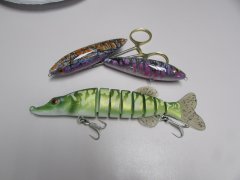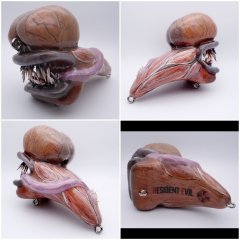-
Posts
7,438 -
Joined
-
Last visited
-
Days Won
238
Content Type
Profiles
Articles
TU Classifieds
Glossary
Website Links
Forums
Gallery
Store
Everything posted by Vodkaman
-
I don't know why they find this site so appealing. We are the least likely group to go for whatever they are offering! Dave
-
Very entertaining post. I have used swimming pools a few times. You would be surprised how accommodating the pool boss can be if you ask. It is such an outlandish request, it will give him something to talk about next time at the bar with his mates. Dave
-
If you are considering mass production numbers then I totally agree with you, stay clear. But, if you are making short runs for your own use, then taking the right precautions, you will do fine. If you are an environmentalist then you will be looking for an alternative. I have poured slugs for my crankbaits without any problems, very low production. I have a 3D print design which will use standard ball bearings. Dave
-

If all the airbrushed in the world suddenly got sucked into a wormhole...
Vodkaman replied to Big Epp's topic in Hard Baits
I would go nude, black or white. For something a bit more fancy, I would float some paint on a bucket of water and lift it onto a dipped body. I can't remember the name of the technique. I do not paint my lures but have no trouble catching fish with them. Dave -
Somehow they are getting paid for these posts, but who is paying them!
-
I am retired and cannot afford to live in UK, and the medical insurance would kill me in USA. Rent and food is very cheap here in Indonesia, the people are friendly and it is always summer. I am face blind (prosopagnosia) and here, I do not have to speak beyond 'hello' as I only speak enough of the language to get by, no conversations. For me, this is a perfect world. Dave
-
For testing, I go to the ponds 30 minutes before the competition, the owner is happy about this. This lure is a small, shallow, hunting crank I developed for this small mouthed fish. The fish is called a bawal. This one is around 3Kg (6.6Lb). Bait fishing, the average weight is 0.5Kg to 1.5Kg, but with lures, the BIG fish come out to play. Dave
-
Stunning fish, and WOW to that scenery. You would laugh at the concrete ponds that I fish, but is all that I have available locally. Besides, I would be devoured by mosquitoes at natural waters. I have 6 concrete stocked competition ponds within a 10 minute cycle, and I win enough to pay for all my fishing needs. Dave
-
I have never ‘fished’ soft plastics, in fact, I have never ‘fished’ hard baits in earnest, only testing to see if they swim and interest the fish. My local fishing waters do not allow lures, only bait fishing allowed, and then, only certain baits and tackle arrangements. Fishing these competition ponds is all about the skill of the angler with bait and tackle being a level playing field. The dictionary defines hybrid as; combining two different elements. My interpretation of hybrid is a lure that combines any of the standard classifications; hard-bait, soft plastic, wire-bait or fly. But, many members define a hybrid as a combination of two different soft plastics. In my opinion, such same genre combinations belong in ‘soft plastics', not ‘hybrids’. It is a complex issue because most wire-baits are a combination of a wire-bait and a soft plastic trailer, technically these are ‘hybrids’ but should be counted as wire-baits. I don’t get involved in any of this as I only do hard-baits with the occasional soft-plastic contribution. Soft-plastics follow the same fluid dynamic rules as hard-baits as do all lures. There is just as much room for innovation in soft-baits as in hard-baits, but members don’t seem to get involved that deep. Soft-plastics is a different style of fishing. As far as I know, soft-plastics will usually win over other types of lure, but I am dedicated to cranks. If you want to get innovative with softies then soft-plastics is where you should post. You can choose to use scientific jargon to explain an action or simply describe the action in visual terms, both are acceptable and constructive. I am an engineer and so I think in engineering terms. You can ask me to explain by post or message, I do not mind at all. I think there is a lot of room for more innovation in softies. Dave
-
Thanks for the complement. 'Sinusoidal' refers to any motion that is smooth and regular, like the graph of A/C voltage. If you view a crankbait from above, the left and right waggle motion is sinusoidal. Sinusoidal meaning the plot of a sine wave. Dave
-
You have been a member for 8 years and posted 82 times, and you ask this question. I don't know what to say. If you were a new member I might suggest to search and read. You would not have to look far as every third post in the hardbait section is about topcoats! Dave
-
Their needs to be a flat between the nose and the tow eye. As I see it, with the rounded shape, a weak vortex is created at the start and sets the lure in motion to one side. BUT, when the next vortex on the other side is formed, it is too weak to change the direction to make the wiggle, and so the lure spirals. A flat, as described above will increase the vortex strength and allow the required change in direction. To test out this hypothesis, a thin plastic flat can be soft glued as described and the edges filled with soft modeling clay or even hot glue might work. Google 'lipless cranks' and note the nose flat. Dave
-
Pete, I fell for that one too. Still, good information. Dave
-
I was a member of a website dedicated to the Thien. I did a quick search but it seems to have disappeared. Still, plenty of articles are available for this simple and effective build. I liked it because it was based on vortices Dave
-
Consider plaster of paris for the mold. POP has a superior finish. Dave
-
Alsworms - sorry if I gave the wrong impression. I did try to word my post so that I was NOT attacking the moderators but merely acknowledging the problem and to offer my services. If you really feel that this post will make the situation worse, then just remove it. No problem here. Dave
-
It seems that TU is having a severe spam problem. Obviously all coming from the same person and possibly the same IP address. If you need a volunteer to help deal with the work load problem then I am at your service. Dave
-

2022 Lure Contest Starting April 1st!
Vodkaman replied to Curt - NC's topic in TU Site Info & Updates
I hope you do stick around, I look forward to reading new ideas. Basically, the gallery is for showing off your work with photos. The forums are for questions and instruction. Photos only permitted if they contribute to the subject under discussion. Dave -
-
-
I have never heard of 'pipes' as a construction technique. Probably labeled different in the software that I use, CATIA V5. Dave
-
-

2022 Lure Contest Starting April 1st!
Vodkaman replied to Curt - NC's topic in TU Site Info & Updates
Every year I get majorly irritated by the contestants that don't read the simple rules. So, this year I decided NOT to read the rules to remind me of the infringements. The ploy has not worked, I am Pd off as much as I ever was. I have entered photography contests many times. The first thing I do is read through the rules at least three times to be sure of the requirements. What is wrong with these people! Dave -
Don't throw out your failed silicone molds. Shread them or cut into small pieces and add to the mix for your next mold. This will save volume of fresh silicone. I believe the silicone sealer (vinegar type) will also serve the purpose for regular silicone, but perhaps someone could confirm. Dave
-
POP warning - do NOT pour any white milky remains down the kitchen sink. It WILL settle and harden. Dave






